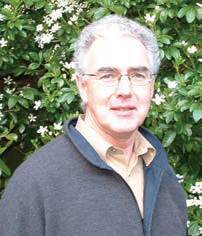Terry O’Regan calls for a grand tree strategy that embraces the total tree population of the state on both public and private lands
I drafted this article as the 75th anniversary of D-Day was being marked on all media with stark images of the landings on the beaches of Normandy. The few remaining veterans and the thousands who died were thanked for the sacrifice they made to save the civilised world of the day. The many forgotten Irish who fought and died in the two world wars are finally being acknowledged.
A well-known recruitment poster for the First World War came to mind, which had the caption ‘Daddy, what did you do in the Great War?’ The universal threats are somewhat different today, and our brave young people are asking new questions – will there be posters before long asking – ‘Daddy, what did you do to save us from Global Warming?’
In the early noughties, I gave a presentation in Enniscorthy. Afterward, a young artist who had worked with me on a National Landscape Forum project in 1999 came up to say hello. I asked him what he was up to and his response caught me off-guard – “I’ve been planting a forest” he said. He went on to explain that he gathered acorns each autumn and planted them into roadside ditches on his rambles around the highways and byways of Wexford.
“Should we be working on a big-picture tree plan?800 mature trees would be destroyed under the national Transport Authority plan to improve Dublin’s bus corridors” |
He was the living embodiment of the visionary booklet by Jean Giono – ‘The Man Who Planted Trees’ – a simple if the profound tale that everyone should read at least once. He also sparked an even earlier memory for me – the tale of Johnny Appleseed – who planted apple seeds on his travels.
In recent weeks, as I worked my way through a rather torturous retirement from running a landscape services business, I began to look afresh at the maturing trees on the many sites throughout Munster and beyond that, I had a hand in planting. I guess I could claim that I planted a forest over the past 50 years – though in truth I cannot claim to have physically planted each tree. However, I was often party to the decision to plant the trees in question.
Typically the force driving the decision was the development planning process and that is a rather blunt instrument. There was rarely an overall tree population strategy or plan guiding the process with the exception of the underdeveloped native species proviso.
As we begin to face up to the full implications of global warming, increasingly volatile climate change and the need to get real about carbon resource management, one has to ask the question, “Should we be working to a big-picture tree plan?”
It is almost 25 years since I first addressed this issue when I spoke in landscape terms of target tree populations and age profiles per-land-use category providing a continuously evolving plan that would guide all players and stakeholders. Such a consistent approach has to be better than random kneejerk reactions to planning applications, sporadic reports and media sound bites.
A case in point was the recent eruption of tree interest generated by the proposal that 800 mature trees would be destroyed under the National Transport Authority plan to improve Dublin’s bus corridors. There were calls for trees to be given priority over buses and buses to be given priority over cars. There were also calls for an ‘urban forest’ approach and replacement trees to be planted as semi-mature specimens rather than saplings.
In early 2018 the National Forestry Report generated a flurry of media criticism when it noted that we were failing to meet the set targets for forestry planting (7% shortfall each year for 2015-17). The 74% shortfall for native woodlands, agroforestry and forestry for fibre was even more depressing. Similarly, the Dublin Tree Canopy Study published in March 2017 concluded that the 10% average tree canopy cover in the four Dublin local authorities was well below the 15% average cover of comparable European cities.
These three episodes of media interest and the reports that prompted the same explain in part why we are failing with regard to addressing the wider environmental disaster that is threatening to overwhelm our species. Ireland is rife with fragmentation, dispersed accountability, the abnegation of responsibility, ill-informed elected representatives and no overall integrated strategies or plans driving and guiding action on the ground. Responsibility for our trees is spread across a whole range of government departments, agencies and more. There is no clear leader with overall responsibility to whom all the fragments are answerable.
So it is difficult to be optimistic that we will reverse this scenario as far as our trees are concerned, because if we could for once be honest we would admit that the country is run in a kneejerk manner, that is more likely to deliver disasters rather than constructive progress.
But optimistic I must be – so I call for a grand tree plan that embraces the total tree population of the state on both public and private lands.
It would appear to me that the Department of Environment should take the lead and draft such a plan drawing all the existing players and stakeholders into the process. The total land area of the state must be provided for and with the inevitable delegation, there should be clear accountability and targets.
This plan should not have a defined life, but rather should set out the long-term tree population and age profile targets for urban, rural and upland areas and it should then have a five-year first phase. A part of this process will have to include a spatial plan for trees! There is no point in talking about more trees if we do not set aside the requisite land to allow them to grow and thrive.
From the perspective of the landscape sector, a first step should be to provide clear, intelligent, realistic guidelines on how best to conserve and manage the tree resource that we currently have and then what and where we should be planting. Such an approach should in time not alone improve our environment but should provide a more sustainable market for our designers, contractors and plant nurseries.
Maybe then we might all plant a forest in our respective lifetimes and be in a position to answer that awkward poster question on your role in the Global Warming War! ✽
  He now divides his time between providing landscape consultancy services in Munster and working as a Council of Europe international landscape and heritage expert in Kosovo. He continues to promote and refine his ‘jargon-free’ landscape circle methodology and is currently leading a pilot study on its use at local and regional administrative levels in Kosovo. The LAI website will shortly be relaunched as www.lai-ireland.com. Contact Terry at terryjoregan@gmail.com or 021 487 1460. |










